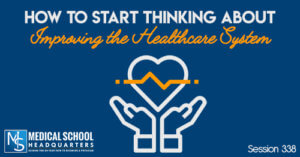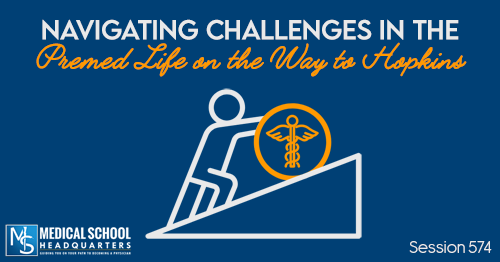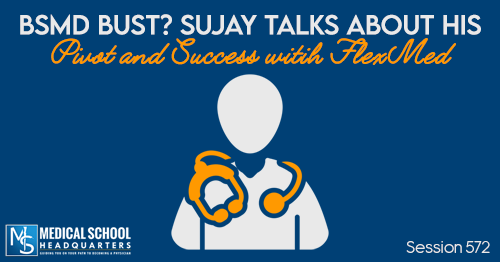Apple Podcasts | Google Podcasts

Session 338
This week, we talk all about process involvement and healthcare systems engineering. Find out exactly how adding this into your knowledge base can help you get better as a premed student, a medical student, a resident, or one day, as a physician.
Ana-Iulia Alexandrescu is the Director of the Healthcare Systems Engineering Program at Lehigh University.
Also, be sure to check out all our other podcasts on the Meded Media for some more tips and resources to help you along your medical school application process and beyond!
[02:26] What is Process Improvement?
Ana explains it’s about how to plan, design, manage, and run systems of healthcare delivery. Healthcare is a very complex system. Systems engineering is how you think about such a system and how you put together processes and systems.
You think about how all those parts can work together in unison so you end up with good patient experiences. It has a myriad of applications in any part of the healthcare system that you can think of.
'Healthcare is a very complex system – lots of moving parts, lots of people, lots of processes, lots of subsystems – and pieces that have to work together.'Click To Tweet[03:40] A Brief Background About Ana
Ana has a background in industrial and systems engineering with an emphasis on operations research. She got into healthcare by accident. She learned more and more about various aspects of healthcare and the way in which healthcare doesn’t work the way it should work or could work.
Once she graduated, she worked for a boutique consulting firm focusing on business process reengineering. Currently, she works with students and industry partners on various healthcare delivery, system-related problems. She solely comes from the engineering perspective, with no clinical background whatsoever.
[05:05] Why Is This Important to Students
As a premed or future medical professional, look at healthcare system engineering as everything that happens outside of the pure interaction with the patient.
For instance, if you’re an emergency medicine physician, you work in a chaotic environment, People keep coming and wait for a very long time. Sometimes, they wait at the emergency department without being seen. Or they wait after being seen and before being transferred to an inpatient bed.
As the ED physician, all of this affects you, your environment. or how care is delivered to the patient. It affects everything about how the emergency department operates.
'If you have a healthcare systems engineering perspective on top of your medicine perspective, you can start looking at ways to do triage differently.'Click To TweetWith a background in healthcare systems engineering, you can look at ways to organize and manage the operations of that emergency department.
People would then have to spend less time waiting. Physicians can then use more time with their patients and on clinical duties rather than on other things that keep them away from practice.
Similarly, the operating room is another environment that has a lot of moving parts and complex operations involved with it.
Do you start a colon cancer surgery with a robot or a do you start it open? What if you can predict the risk of having to switch from robot to open because of the likelihood of complications based on information available before the surgery?
How do you sequence your surgeries? Do you put the longest surgery first, or the shortest surgery first? How do you manage your day such that you minimize disruptions, spend less time idle and waiting for things to happens so that you can get on with your day?
How can you be more effective and more efficient, and therefore provide overall better care in a more pleasant and well-functioning environment?
[08:16] Your Edge as the Physician
Additionally, as an engineer, Ana can look at your schedule as a surgeon and give you recommendations on how to improve that schedule or make it less likely to run long or for certain surgeries to be canceled. She can help you be better at predicting how long the surgery will take.
That being said, there are decisions that Ana doesn’t have access to because of the lack of clinical information. So while she can give you the reasoning or the logic behind some decisions, but she lacks the clinical context to push that beyond a certain level.
'You can go a lot further and apply some of these concepts into designing new treatment protocols.'Click To TweetBut you as a clinician with this kind of mindset, you don’t have that barrier. You can design new ways of approaching diagnoses and new ways of practice. You can have better care delivery models and so on.
[09:30] A Case Study: Application in Colorectal Surgery
Ana worked with a resident in colorectal surgery and a colorectal surgeon to look at predicting the likelihood of success in doing robotic surgery versus open surgery.
So the questions were two-fold.
First, are the outcomes for patients worse when they start off with the robotic surgery then switch to open surgery part-way thru because of a complication during surgery?
Second, based on the information available prior to the surgery, could they predict the likelihood of that switch happening?
Given the risk tolerance and the surgeon’s evaluation of that risk, can they make an informed decision whether this surgery is better to be done by a robot? Or is it better to switch to open surgery, to begin with?
They used data from over 600,000 surgeries performed in the U.S. The results showed that the outcomes are worse for patients that start with robotic surgery and switched open versus those that completed open surgery.
The predictive model also achieved a relatively good performance. This could be further improved. But it’s a starting point to at least build that kind of reasoning in the decision-making process prior to colorectal surgery.
[13:00] The General Idea
Looking at the patient outcome difference is just one aspect of it. There are operational implications to making that decision even if there may not be patient outcomes.
For example, there were no differences between patients who started with robot and switched to open versus those who started with open surgery. So from a patient recovery and experience perspective, it didn’t make a difference.
But that doesn’t mean it didn’t make a difference from a system perspective. What disruption does it cause to other surgery schedule that day? To the patient recovery planning, robotic surgery would be much less invasive versus open surgery, where patient recovery is a lot longer.
What implication does this have, not just on the patient level, but also on all the operations in the hospital, around that particular surgery?
This is also bad for the patients in the ICU because it’s a very restrictive environment. A number of different services a patient might need are not actually available or possible in the ICU. Overall, this results in less optimal patient care for the patients stuck in the ICU longer than necessary.
However, the number of decisions that are being made are staggering doing many and deeply clinical, so as a pure engineer, Ana doesn’t have the authority or the basis to make specific recommendation on how to fix it. She can have many ideas and analyze many ways in which this could be made better.
'It takes a clinical mind and a clinical understanding of the processes in order to be able to improve this particular situation.'Click To Tweet[17:35] Application of Process Improvement in Your Daily Life
A lot of these principles have been applied in other industries and other processes and systems. And you see the results in a lot of everyday life.
A lot of us that have prime membership get deliveries in two days, pretty much everywhere in the United States. This is only possible through a very robust analytical platform. It takes a way of thinking, predicting demand, and trying to anticipate what will be required. You have to be relentless in improving operations for delivery. There’s been an announcement that Amazon is experimenting with one-day delivery.
Another example is if you get a credit card statement, it’s usually easy to read. If you get a healthcare bill, many people can’t read them as they’re much more complicated.
'There have been efforts in many other industries to become more customer-focused.'Click To Tweet[19:23] Process Improvement in the Airline Industry
Another example is a comparison of healthcare and airlines. If you’re trying to fly from New York to Seattle, you’re probably going to have to connect. But you don’t have to buy your luggage pass separately. You don’t have to manage how your luggage makes it from one connection to another.
However, the healthcare is not as streamlined as this. People oftentimes have to piece together across the system what they need.
And even when you buy an iPhone, you’re guaranteed for it to be the same as the next iPhone. The fact that iPhone is in some way better or superior to the previous iPhone is the same idea, which is this relentless pursuit of better, improved, and excellent product.
[20:52] The 5S Methodology
The 5S methodology talks about how you manage your tools and your work environment. You can apply this even to how you organize your desk or closet. The idea is having a place for everything and putting everything in its place. This makes it easy for you to figure out when you’re missing something.
'Coming up with a system that keeps you organized, significantly reduces the amount of time you have to spend looking for things.'Click To TweetIn surgical cases, this would translate into having a tray that has all the necessary instruments in their proper place. So when one of them is missing, you can notice immediately that it’s missing.
You can also shorten the amount of time it takes to retrieve the correct instrument. Because it’s always in the same place, you don’t have to search for it. This is especially helpful when you’re doing many different surgeries. And if you have to search for an instrument every single time across a set of 50, this can add up.
[22:15] Root Cause Analysis
We always say you should treat the cause rather than the symptom. Root cause analysis has many different flavors or variations. But essentially, it’s a systematic approach to trying to understand why a certain symptom or effect has been observed.
One way to do this is through the Toddler Methodology where you keep asking why. They recommend five times. Sometimes, you may need to ask more than 5 why’s. You can do that and get to the bottom of things.
'Until you get to that deep level of why, you would be making a lot of wrong decisions... without actually realizing what the true problem is.'Click To Tweet[26:18] The Kitchen Example
For instance, you’re emptying the dishwasher, you don’t put your silverware in the drawer in another room. You put it in your kitchen drawer. That makes the most sense as you don’t have to walk around the different parts of your house.
'Kitchens are a perfect example of studying principles of good processes and good system design.'Click To TweetWhen you take something out of the fridge, do you need to put it on the counter or do you need to wash it or chop it? You don’t want your sink and fridge to be far apart.
When you wash things or drain things, you usually want to go from the sink to the stove top. You don’t want those to be across the room either. You would be surprised how many poorly designed kitchens there are out there.
[28:58] Learning Process Improvement in Healthcare
Residency programs have started requiring process improvement projects as part of the residency. There is an increased understanding in perspective from the clinical community. They now recognize the need to train healthcare professionals, medical students, and residents in how to think and approach improving processes and systems.
One of the hardest things to change is to change something that you’ve been doing in one particular way forever and ever. Getting into that habit of thinking critically at how you do things and how you do them better is a really important skill to have.
More recently, AMA has launched new guidelines for the kinds of things you should be studying in medical school. There’s this push for the idea of healthcare delivery system science.
'We need to think about medicine and the practice of medicine as a team sport that has a lot of different moving parts that automatically requires a set of tools, models, and patterns.'Click To Tweet[31:05] Courses Offered at Lehigh and Recommended Resources
Their university offers courses dedicated to understanding process improvement and understanding finance in relation to a hospital level and a physician’s perspective.
They also have courses in information systems. Students will understand how they can utilize information systems to drive decision making.
'We try to give premed students a well-rounded perspective on what it is to be a healthcare professional and what it is to think about systems of healthcare delivery.'Click To TweetEverything they learn in medical school overlays on a different concept of medicine and care delivery.
Ana recommends different books students can check out on process improvement including The Innovator’s Prescription: A Disruptive Solution for Health Care by Clayton M. Christensen
as well as books about the Toyota production system.
Examples of organizations that have adopted the mindset of continuously improving and striving for better include Virginia Medicine, ThedaCare, Intermountain Healthcare, and Mayo Clinic.
Find out more about Lehigh University and the courses they offer on their website. Also check out the different resources you can link to from their website.
In 2014, the President’s Council of Advisors on Science and Technology (PCAST) published a report on the need for systems engineering and system thinking in healthcare. This wasn’t only limited to clinical professionals but also touching all the different areas of healthcare.
They provided examples of specific applications of systems engineering in healthcare in many different settings. They laid out why this kind of mindset is needed in healthcare and why it should be built.
Personally, I would not recommend this Master’s program if you’re looking at improving your GPA so you use this as your postbac program. But this is the program for you if you’re really interested in process improvement and healthcare systems engineering.
You can have this knowledge base for your future practice or if you’re thinking about going into administration. That being said, you don’t really need to go through a Master’s program to start learning all this information.
Links:
Book recommendations:
The Innovator’s Prescription: A Disruptive Solution for Health Care by Clayton M. Christensen
The Goal by Eliyahu M. Goldratt











